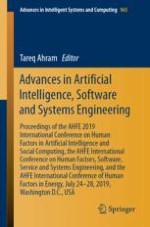2020 | Book
Advances in Artificial Intelligence, Software and Systems Engineering
Proceedings of the AHFE 2019 International Conference on Human Factors in Artificial Intelligence and Social Computing, the AHFE International Conference on Human Factors, Software, Service and Systems Engineering, and the AHFE International Conference of Human Factors in Energy, July 24-28, 2019, Washington D.C., USA
Editor: Prof. Tareq Ahram
Publisher: Springer International Publishing
Book Series : Advances in Intelligent Systems and Computing
